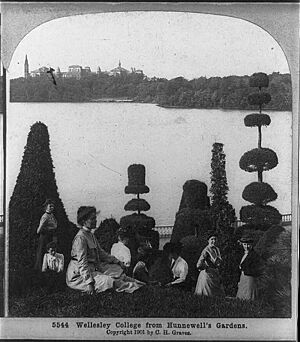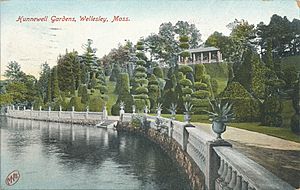H. H. Hunnewell estate facts for kids
The H. H. Hunnewell estate is a very special country home in Wellesley, Massachusetts. It belonged to H. H. Hunnewell (1810–1902). This huge estate has over 500 types of woody plants from 53 different plant families.
What makes it super cool? It has the very first topiary garden in the United States, started in 1854! Topiary means plants that are carefully clipped into cool shapes. Here, they use Eastern white pine and Eastern arborvitae trees. The estate also has special greenhouses with more than 1,000 different plant species. Six generations of the Hunnewell family have taken care of this amazing place.
You can find the estate in the Hunnewell Estates Historic District in southwest Wellesley. It's close to Boston, Massachusetts. Just remember, all the homes in this area, including the Hunnewell estate, are private. They are not open to the public.
Contents
History of the Hunnewell Estate

Around 1843, H. H. Hunnewell started planning the gardens for his new estate. He loved planting evergreen trees from all over the world. Many of these trees had never been grown in the United States or in New England before. By 1847, he had planted over 2,000 trees! These trees came from England and included more than two dozen different types.
The main house was built later, in 1851. It was designed by Arthur Gilman in the Italianate style. This means it looked like buildings from Italy.
The Famous Rhododendrons
The rhododendrons at the Hunnewell estate might be the oldest ones grown in the U.S. H. H. Hunnewell began bringing them in and planting them in the 1850s and 1860s. Some of these original plants are probably still alive today!
In 1873, he held the first big show of rhododendrons in the U.S. It was on Boston Common. This show helped make these beautiful flowers very popular for gardens and parks across America.
A Visit from John Muir
In 1898, a famous naturalist named John Muir visited Mr. Hunnewell. He came with Charles Sprague Sargent, who was the first director of the Arnold Arboretum. Muir wrote in his diary that Hunnewell had planted almost every tree there himself. He started planting when he was 45 and was 88 when Muir visited! Only one old oak tree, about 250 years old, was there before him.
In 2010, the International Dendrology Society gave its highest award to the Hunnewell estate. It was the first time an American garden received this special honor!
Exploring the Pinetum
The pinetum is a special part of the garden where many different types of pine trees and other cone-bearing trees (conifers) are grown. The Hunnewell pinetum started in 1867. It has some very rare and old trees.
You can find trees like the Torreya nucifera (Japanese nutmeg yew) and the Tsuga canadensis pendula (Sargent's weeping hemlock). There's also a Cedrus libani (Cedar of Lebanon) and a Juniperus formosana (Taiwan juniper). One of the oldest Metasequoia glyptostroboides (dawn redwood) trees in the U.S. is also here.
In front of the 1851 house, there is a giant European beech tree with weeping branches. The collection also includes huge Pinus strobus (Eastern white pine) trees. You can also see American white and English Oaks, lindens, tulip trees, bald cypress, and Chinese golden larch. Plus, there are many kinds of azaleas, lilacs, viburnums, hollies, weeping cherries, mountain laurel, and rhododendrons.
The Hunnewell Pine
Did you know there's a tree named after the estate? The Hunnewell pine, or Pinus x hunnewellii, is a hybrid tree. This means it's a mix of two different trees: the Eastern white pine and the Japanese white pine. It was first grown at the Hunnewell estate in 1952!
Not to Be Confused With...
It's important not to mix up the H. H. Hunnewell estate with the H. H. Hunnewell Arboretum at Wellesley College Botanic Gardens. That arboretum is across Lake Waban, a different place entirely!


